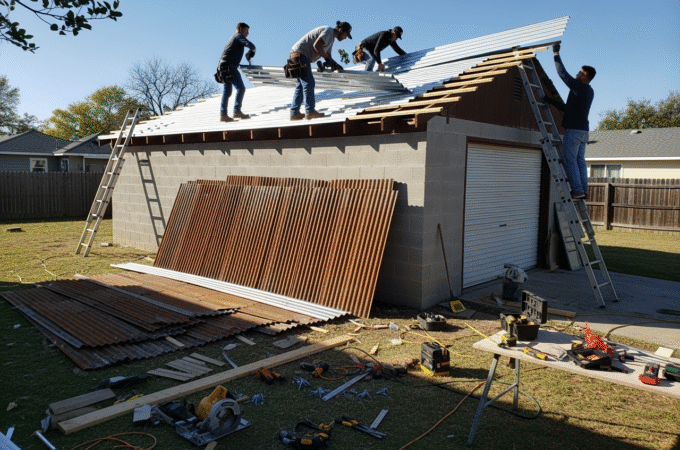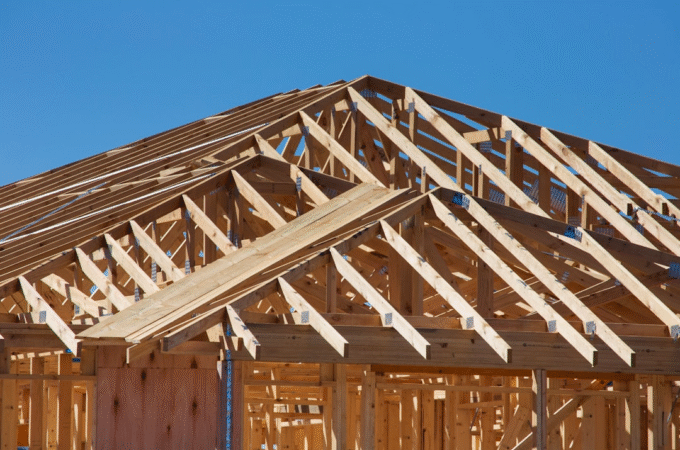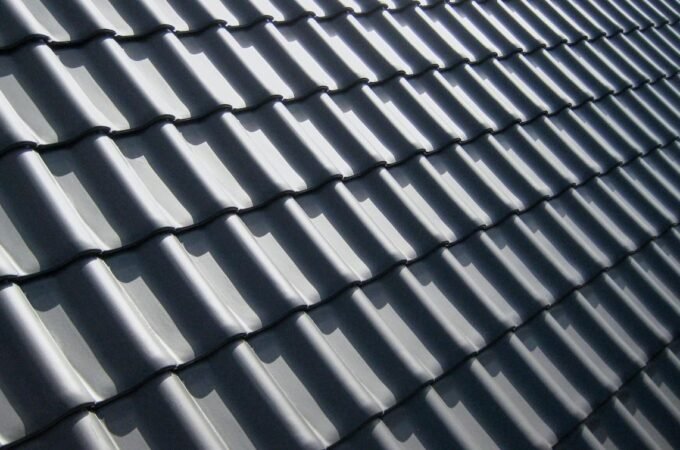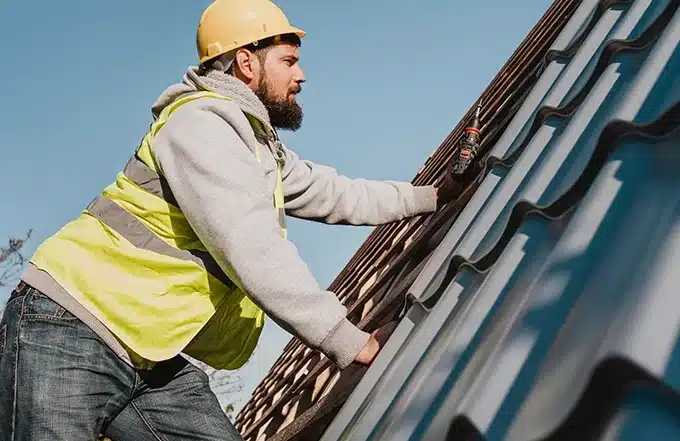
How to Choose the Right Roofing Material for Your Home
Table of Contents
ToggleWhy Roofing Materials Matter
Your roof is one of the most vital components of your home’s protection system, shielding your living spaces from rain, snow, extreme temperature swings, pests, and UV radiation. Every day, your roof endures a significant amount of wear and tear, acting as the primary barrier between harsh weather conditions and your family’s comfort and safety. The right roofing material directly impacts your property’s defense against the elements as well as overall energy efficiency. According to the U.S. Department of Energy, energy-efficient roofing options have been proven to reduce household cooling requirements by up to 15% in some climates, saving money while reducing your environmental impact. Besides keeping your home safer and more comfortable, a well-maintained roof can enhance curb appeal and even increase market value, which is especially important if you plan to sell your home in the future. Additionally, keeping an eye out for signs of wind damage to roof is crucial, as unnoticed damage may result in costly repairs or premature roof replacement.
Understanding how various roofing materials respond to wind, moisture, and temperature changes is critical for every homeowner, especially in areas known for harsh weather. For example, homes in coastal regions face challenges such as salty air that can corrode certain materials. At the same time, properties in snowy areas need roofs that can handle heavy loads and prevent ice dams. Regular inspections and proactive repairs based on expert advice can extend the life of your roof and prevent small issues from becoming major headaches. Selecting the appropriate material isn’t just about looks; it’s about safeguarding your home’s investment and protecting those who live inside.
Factors to Consider Before Making Your Choice
Choosing the ideal roofing material isn’t a one-size-fits-all decision. Your region’s climate conditions play a major role, from hail-prone areas to zones with high humidity or frequent temperature shifts. Materials that perform well in dry, hot climates may not offer the moisture resistance needed for frequent rainy seasons. Local building codes and homeowner association guidelines may also limit your options, so it’s essential to check regulations before committing. These codes might dictate not only material types but also color or style restrictions to maintain a consistent neighborhood appearance.
Architectural style matters as well; a Mediterranean-style home may look best with clay tiles, while traditional homes often suit asphalt shingles. Furthermore, it’s important to consider personal priorities—such as eco-friendliness, maintenance requirements, up-front costs, and desired lifespan—which will significantly shape your ultimate selection. Don’t overlook long-term factors like potential insurance savings, resale value, or how easily materials can be repaired or replaced after severe weather. Also, remember to factor in your household’s future plans. If you expect to move in five years, your priorities will differ from those of someone seeking a lifetime investment. Prioritize your unique needs and long-term plans to ensure you make a sustainable investment tailored to your specific situation.
Popular Roofing Material Options
Today’s homeowners can choose from a broad array of roofing materials, each with unique attributes and benefits. The market has expanded well beyond traditional options, providing solutions for a wide range of budgets, climate zones, and architectural preferences:
- Asphalt Shingles: The most common option in North America. They’re affordable, easy to install, and available in many colors, though their lifespan (15–30 years) is generally shorter than other types. Asphalt shingles are suited for a variety of roof shapes and slopes and have improved in quality over the years, now offering better resistance to algae, fire, and wind.
- Metal Roofing: Known for its impressive durability, energy efficiency, and contemporary appearance. Metal can last 40–70 years, but may require soundproofing in areas with heavy rainfall. Modern metal roofs come in styles that mimic shingles, tiles, or even wood shakes, combining aesthetic flexibility with functional performance. They are also fire-resistant and can shed snow quickly, making them ideal for colder climates.
- Slate: A luxurious, natural stone material that can last 75–100 years or more. It’s heavy, expensive, and usually reserved for robust, historic homes. Slate is virtually impervious to water, fire, and pests, and it offers distinctive, timeless beauty that’s hard to replicate with other materials.
- Clay and Concrete Tiles: Purposely designed for longevity and resistance to fire and insects; ideal for hot, dry climates. They’re heavy and typically more costly to install. Clay and concrete tiles often exhibit natural thermal properties that help regulate indoor temperatures, contributing to both comfort and long-term energy savings.
- Synthetic Roofing: Innovations in rubber, plastic, and polymer blends replicate the look of natural materials like slate or wood, but at lower weights and cost, often with excellent durability. Synthetics provide resistance to cracking, fading, and warping, and are usually easier to install and replace than their natural counterparts.
Comparing Durability and Longevity
Lifespan and maintenance differ widely among roofing materials. According to the National Roofing Contractors Association, asphalt shingles offer about 20 years of reliable service with routine maintenance, while metal roofs often exceed 50 years with minimal intervention. The longevity of a roof depends not just on the material itself, but also on factors like installation quality, roof pitch, and ongoing care. Slate and tile roofs set the gold standard for durability, but may be cost-prohibitive for many homeowners. Synthetics can offer lifespans of 30–50 years, depending on product quality and installation standards. It pays to invest in materials with proven track records for your climate and to work with experienced roofing professionals.
Maintenance needs also vary: Wood shakes and shingles may demand frequent cleaning and treatments to prevent moss growth, warping, or insect infestations, while metal and synthetics require basic inspections and occasional cleaning. Even roofs made from ultra-durable materials benefit from regular upkeep and monitoring. Ensuring proper attic ventilation and prompt repairs in response to common issues are vital for extending roof life, no matter the material. Failure to address minor problems early can speed deterioration and decrease your roof’s expected lifespan.
Energy Efficiency and Environmental Impact
The choice of roofing material plays a major role in your home’s ability to maintain consistent indoor temperatures and minimize heating/cooling expenses. Lighter-colored metal roofs and “cool roof” shingles, for example, reflect more solar energy and keep attics cooler, helping lower air conditioning costs during the summer months. Materials like clay tile and slate possess natural insulating properties, helping to regulate heat exchanges throughout the year. This can create a more comfortable living environment while reducing your home’s dependence on mechanical heating and cooling.
Some synthetic tiles are even made from recycled materials, reducing landfill waste and lowering your carbon footprint. Green roofing options may also offer added benefits, such as integrating solar shingles or living roofs with vegetation, though these tend to require more specialized installation. Considering the entire lifecycle—from extraction to disposal—helps you make environmentally responsible choices. If sustainability is a top priority for you, look for roofing options that offer high recycled content, can be recycled at the end of their lifespan, or have lower overall energy usage for your household.
Cost vs. Value: How to Budget Effectively
Up-front costs for roofing materials range from inexpensive asphalt shingles to premium slate or clay tile, but it’s wise to consider total lifetime value rather than only initial expenditures. Less expensive options may require earlier replacement and more frequent ongoing maintenance, while premium materials offer long-term savings through increased longevity and reduced repair costs. Investing a bit more at the start might significantly reduce your costs down the line, particularly if you live in a region with extreme weather. Factor in energy savings, reduced insurance premiums, and potential resale advantages that come from a quality roof with outstanding curb appeal. Determining the best fit for your budget often comes down to weighing immediate affordability against projected future expenses and your home’s location, age, and level of exposure to harsh conditions.
Key Questions to Ask Your Roofer
- Are you licensed, insured, and experienced with my preferred roofing material?
- What warranties cover materials and workmanship, and for how long?
- Can you provide recent references and local examples of similar installations?
- How will you handle ventilation, flashing, and water drainage details?
- What’s your process for managing unforeseen damage or additional repairs?
Asking these questions helps ensure that you hire a qualified roofing professional who will install your chosen material correctly and handle any potential complications that may arise, thereby protecting your investment for years to come.
Roof Maintenance Tips for Long-Term Performance
- Perform visual inspections every spring and fall, watching for missing or damaged shingles/tiles, signs of moss, or rust on metal flashing. Catching small issues early can prevent leaks and extend the service life of your roof.
- Clean gutters and downspouts regularly to prevent water backup and leaks. Blocked gutters can cause water to pool on the roof, encouraging mold growth and structural damage.
- Trim trees and remove debris that could cause abrasion or moisture retention on the roof surface. Overhanging branches can puncture or scrape roofing materials during storms.
- Check attic ventilation and insulation yearly to prevent heat or moisture buildup. Maintaining balanced airflow helps avoid condensation, ice dams, and premature aging of roofing components.
- Schedule professional inspections after major storms, especially if you notice issues like curling shingles or unexplained water stains indoors. Prompt attention following severe weather events can stave off costly repairs.
Routine upkeep not only avoids expensive problems but also upholds warranties, preserves aesthetic appeal, and prolongs the expected life of your roof.
Conclusion: Making Your Final Decision
There isn’t a single “best” roofing material for every home—your climate, budget, aesthetic preferences, and long-term needs will all play a role in what’s right for you. Take your time weighing each factor, use expert resources, and don’t hesitate to consult professionals who understand the latest materials and techniques. A thoughtful, informed approach will help you balance short-term constraints with your long-term goals, matching your home’s design to a material that offers the performance you need. With preparation and attention to detail, your new roof will deliver both performance and peace of mind for decades to come.






